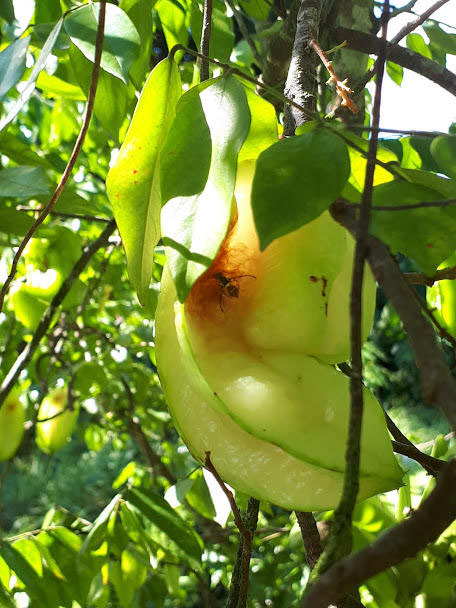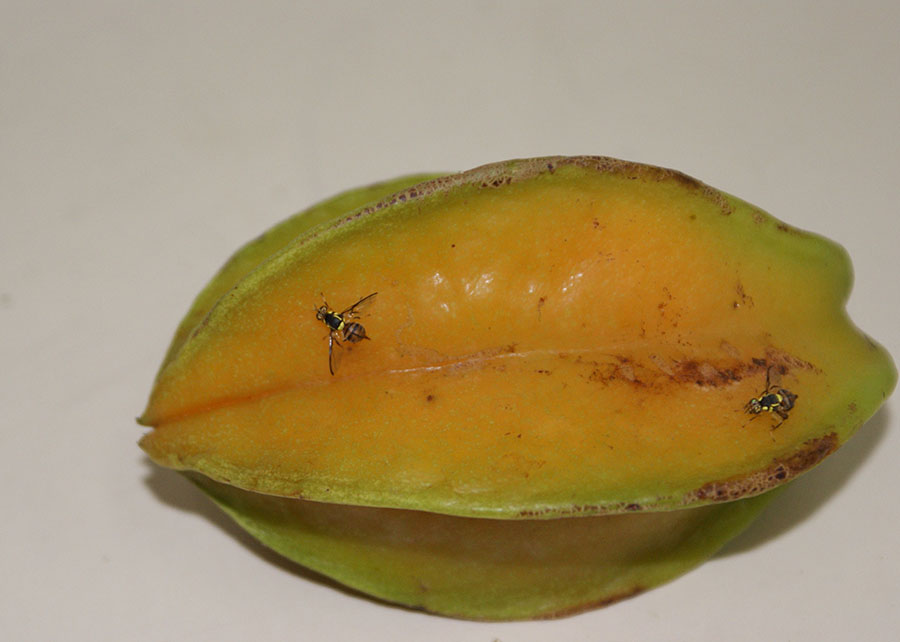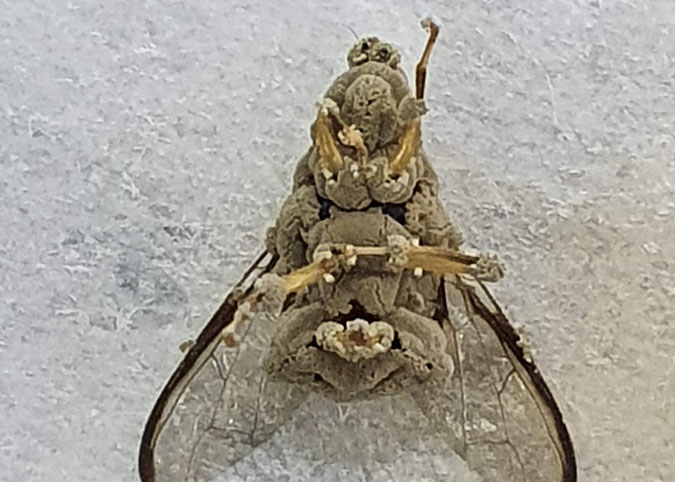In field tests, the new bioinsecticide promoted up to 87% carambola fruit fly mortality Bioproduct uses fungus isolated from soil in the capital of Amapá state. Control of insect pests occurs through direct application to the soil, and affects their larvae, pupae and adults. It is non-toxic, leaves no trace and has potential for the control of three species of flies that are pests in fruit farming. Embrapa is looking for partners in the production sector to bring the bioinsecticide to the market. Embrapa Amapá has developed a microbiological insecticide to fight fruit fly species, including the quarantine pest carambola fruit fly (Bactrocera carambolae), present throughout the Brazilian state of Amapá and in restricted areas of Roraima and Pará, other states in the north of the country. The new bioinsecticide is based on the fungus Metarhizium anisopliae, which was isolated from a soil in the city of Macapá, Amapá. Because it was obtained in an Amazonian environment, the microorganism is ideal for the control of fruit flies that occur in tropical environments. Embrapa researchers attested to the action potential of this technological asset, both at national and international level, to control the following species of fruit flies: Bactrocera carambolae (carambola fruit fly), Anastrepha fraterculus, Ceratitis capitata (Mediterranean fruit fly) and Bactrocera dorsalis (oriental fruit fly). All of them are of economic importance for fruit farming. The carambola fruit fly alone has already been identified in 26 fruit trees such as guava, mango, starfruit (a.k.a. carambola), Barbados cherry (a.k.a. acerola), citrus, mandarin, cashew, rose apple and bitter orange trees, according to studies by Embrapa Amapá. Therefore, it can have a large economic impact on such crops in the country. According to researcher Adilson Lopes Lima, although the damage caused to the fruits does not cause illnesses in humans, the main motivation to eradicate the carambola fruit fly is to avoid its spread to areas of commercial fruit production for exports, especially the lower middle São Francisco river valley, in the Brazilian Northeast, which is the largest mango production and export hub in Brazil, with a planted area of approximately 12,000 hectares. This bioinsecticide is the first product formulated with the fungus Metarhizium anisopliae to control carambola fruit flies. The host insect is eliminated by applying the product directly onto the soil As it has no toxicity and leaves no trace, there are no similar products in the market for both the carambola fruit fly and the fruit flies species Anastrepha fraterculus and Ceratitis capitata. Photo: Cristiane de Jesus How the bioinsecticide works Fruit farmers have to apply the bioinsecticide in the canopy cover (area of the forest floor covered by the vertical projection of the tree crown) of the host fruit trees. The results showed that in field conditions, the percentage of control obtained with the technology was high: up to 87%. The researcher says that the biological control of agricultural pests is a sustainable alternative to reduce or replace the use of synthetic chemical insecticides. In this context, the use of natural enemies of insect pests such as entomopathogenic fungi (i.e. fungi that attack and kill insects) has grown considerably. The product does not pose a risk to the environment and works on the larvae, pupae and adults of the pest while they are still in the soil. As for adult insects coming out of the treated soil, most emerge infected and die before completing the pre-oviposition period, and thus do not produce offspring. Technology ready for business partnerships With the status of asset that is ready for product formulation, the technology awaits private sector partners that are interested in producing and trading it. Embrapa offers opportunities to improve studies to grow the product's shelf life, and additional testing for other insect species of economic importance. The bioinsecticide will also be assessed in the control of the South American fruit fly [Anastrepha fraterculus (Wiedemann ]and the Mediterranean fruit fly [Ceratitis capitata (Wiedemann)], which have a life cycle that is similar to the carambola fruit fly's. Companies interested in signing commercial cooperation agreements can contact cpafap.chtt@embrapa.br Photo: Danilo Nascimento "Using this microorganism formula to control the carambola fruit fly is a concrete possibility, since it offers high effectiveness and it is easy to producte on a commercial scale," Lima asserts. The phylogenetic and life-cycle similarity of target pests could promote expansion to other potential markets. "The carambola fruit fly (Bactrocera carambolae) is a species that is part of the Bactrocera dorsalis complex, with about 85 species that are genetically very close," according to the research team. Lima states that, considering B. dorsalis is one of the most destructive agricultural pests in the world and one of the most limiting factors in the international trade of fresh fruits, the use of the Embrapa asset in question has the potential for significant economic, social and environmental impacts. Photo: Danilo Nascimento Advantages of bioinsecticide with Metarhizium anisopliae Proven efficacy for the control of larvae, pupae and adults of the carambola fruit fly (Bactrocera carambolae). Endemic isolate from the northern region of Brazil, available exclusively in Embrapa's collection (Embrapa Genetic Resources Biotechnology and Embrapa Amapá). Fungal conidia (active ingredient) not yet used in any commercial formula in Brazil or abroad.. There are no other microorganism isolates with similar results for carambola fly control. It does not require additional equipment for application at rural property level. More information about this technological asset is available on Embrapa's web portal. Photo: Cristiane de Jesus
Embrapa Amapá has developed a microbiological insecticide to fight fruit fly species, including the quarantine pest carambola fruit fly (Bactrocera carambolae), present throughout the Brazilian state of Amapá and in restricted areas of Roraima and Pará, other states in the north of the country. The new bioinsecticide is based on the fungus Metarhizium anisopliae, which was isolated from a soil in the city of Macapá, Amapá. Because it was obtained in an Amazonian environment, the microorganism is ideal for the control of fruit flies that occur in tropical environments.
 Embrapa researchers attested to the action potential of this technological asset, both at national and international level, to control the following species of fruit flies: Bactrocera carambolae (carambola fruit fly), Anastrepha fraterculus, Ceratitis capitata (Mediterranean fruit fly) and Bactrocera dorsalis (oriental fruit fly). All of them are of economic importance for fruit farming.
Embrapa researchers attested to the action potential of this technological asset, both at national and international level, to control the following species of fruit flies: Bactrocera carambolae (carambola fruit fly), Anastrepha fraterculus, Ceratitis capitata (Mediterranean fruit fly) and Bactrocera dorsalis (oriental fruit fly). All of them are of economic importance for fruit farming.
The carambola fruit fly alone has already been identified in 26 fruit trees such as guava, mango, starfruit (a.k.a. carambola), Barbados cherry (a.k.a. acerola), citrus, mandarin, cashew, rose apple and bitter orange trees, according to studies by Embrapa Amapá. Therefore, it can have a large economic impact on such crops in the country. According to researcher Adilson Lopes Lima, although the damage caused to the fruits does not cause illnesses in humans, the main motivation to eradicate the carambola fruit fly is to avoid its spread to areas of commercial fruit production for exports, especially the lower middle São Francisco river valley, in the Brazilian Northeast, which is the largest mango production and export hub in Brazil, with a planted area of approximately 12,000 hectares.
This bioinsecticide is the first product formulated with the fungus Metarhizium anisopliae to control carambola fruit flies. The host insect is eliminated by applying the product directly onto the soil As it has no toxicity and leaves no trace, there are no similar products in the market for both the carambola fruit fly and the fruit flies species Anastrepha fraterculus and Ceratitis capitata.
Photo: Cristiane de Jesus
How the bioinsecticide works
Fruit farmers have to apply the bioinsecticide in the canopy cover (area of the forest floor covered by the vertical projection of the tree crown) of the host fruit trees. The results showed that in field conditions, the percentage of control obtained with the technology was high: up to 87%.
The researcher says that the biological control of agricultural pests is a sustainable alternative to reduce or replace the use of synthetic chemical insecticides. In this context, the use of natural enemies of insect pests such as entomopathogenic fungi (i.e. fungi that attack and kill insects) has grown considerably.
The product does not pose a risk to the environment and works on the larvae, pupae and adults of the pest while they are still in the soil. As for adult insects coming out of the treated soil, most emerge infected and die before completing the pre-oviposition period, and thus do not produce offspring.
 Technology ready for business partnerships Technology ready for business partnerships
With the status of asset that is ready for product formulation, the technology awaits private sector partners that are interested in producing and trading it. Embrapa offers opportunities to improve studies to grow the product's shelf life, and additional testing for other insect species of economic importance. The bioinsecticide will also be assessed in the control of the South American fruit fly [Anastrepha fraterculus (Wiedemann ]and the Mediterranean fruit fly [Ceratitis capitata (Wiedemann)], which have a life cycle that is similar to the carambola fruit fly's. Companies interested in signing commercial cooperation agreements can contact cpafap.chtt@embrapa.br Photo: Danilo Nascimento |

"Using this microorganism formula to control the carambola fruit fly is a concrete possibility, since it offers high effectiveness and it is easy to producte on a commercial scale," Lima asserts.
The phylogenetic and life-cycle similarity of target pests could promote expansion to other potential markets. "The carambola fruit fly (Bactrocera carambolae) is a species that is part of the Bactrocera dorsalis complex, with about 85 species that are genetically very close," according to the research team.
Lima states that, considering B. dorsalis is one of the most destructive agricultural pests in the world and one of the most limiting factors in the international trade of fresh fruits, the use of the Embrapa asset in question has the potential for significant economic, social and environmental impacts.
Photo: Danilo Nascimento
 Advantages of bioinsecticide with Metarhizium anisopliae Advantages of bioinsecticide with Metarhizium anisopliae
- Proven efficacy for the control of larvae, pupae and adults of the carambola fruit fly (Bactrocera carambolae).
- Endemic isolate from the northern region of Brazil, available exclusively in Embrapa's collection (Embrapa Genetic Resources Biotechnology and Embrapa Amapá).
- Fungal conidia (active ingredient) not yet used in any commercial formula in Brazil or abroad..
- There are no other microorganism isolates with similar results for carambola fly control.
- It does not require additional equipment for application at rural property level.
More information about this technological asset is available on Embrapa's web portal. Photo: Cristiane de Jesus |

 Embrapa researchers attested to the action potential of this technological asset, both at national and international level, to control the following species of fruit flies: Bactrocera carambolae (carambola fruit fly), Anastrepha fraterculus, Ceratitis capitata (Mediterranean fruit fly) and Bactrocera dorsalis (oriental fruit fly). All of them are of economic importance for fruit farming.
Embrapa researchers attested to the action potential of this technological asset, both at national and international level, to control the following species of fruit flies: Bactrocera carambolae (carambola fruit fly), Anastrepha fraterculus, Ceratitis capitata (Mediterranean fruit fly) and Bactrocera dorsalis (oriental fruit fly). All of them are of economic importance for fruit farming. 


